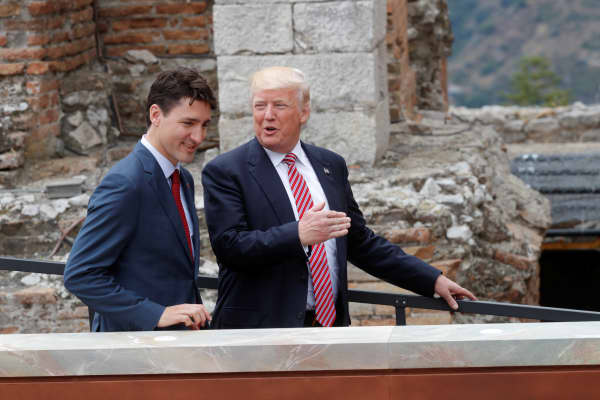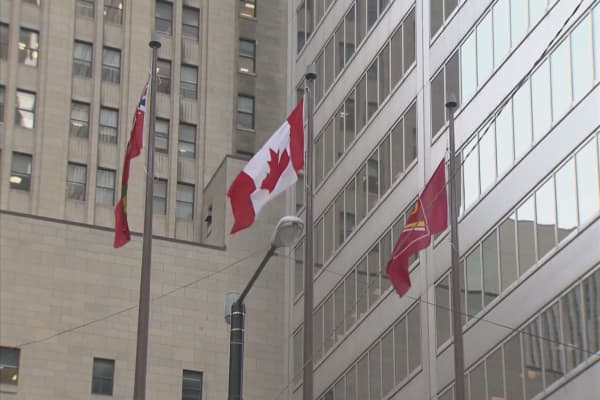Canadians may pay more taxes than Americans, but here's what they get for their money
Even with all kinds of taxes considered, including income, local and sales taxes, among others — and contrary to what President Donald Trump has repeatedly said — Americans do not pay the highest taxes in the world. Not even close. Actually, the U.S. is a little below average compared to our 34 peer countries in the Organization for Economic Cooperation and Development (OECD).
But what about Canada? Given all the social services that Canadian citizens enjoy relative to their neighbors to the south, including health care, many Americans assume that Canadians bear a significantly heavier tax burden.
The reality is more complex.
Canadians pay more — sometimes
The OECD analyzes the tax burdens of 35 countries, including the United States and Canada. According to its data, in terms of total tax revenue as a percentage of GDP, in 2010, the U.S. collected a slightly lower than average amount of taxes from its citizens ($11,365 USD per capita). Canada collected a slightly higher than average amount ($14,693 USD).
The average for OECD countries was $12,911 USD.
That total tax revenue figure includes not merely federal income taxes, but all taxes, including "taxes on income and profits, social security contributions, taxes levied on goods and services, payroll taxes, taxes on the ownership and transfer of property, and other taxes."
OECD (2017), Tax revenue (indicator). doi: 10.1787/d98b8cf5-en (Accessed on 01 August 2017)
At times, for example, in 2000 and again in 2014, Canada and the U.S. swapped places. The U.S. paid a slightly higher than average amount and Canada paid a slightly lower than average amount. For the most part, however, both countries hover around the OECD average.
And both remain far lower than high-tax countries such as Luxembourg, Norway, Denmark Switzerland and Sweden.
"Canada's total tax revenue over all levels of government as a percentage of GDP is modest relative to our OECD peers," reports the Broadbent Institute. "Of all 35 OECD countries, Canada ranks 25th in terms of total tax revenue to GDP."
Here's how much individuals pay
Because Canada has a progressive tax system much like America's, the amount any individual pays varies according to their circumstances. The typical Canadian family pays an effective total tax rate of 24 percent, according to Broadbent.
The effective total tax rate for Americans varies, too: "The top 1 percent of American taxpayers still pay an effective tax rate of approximately 31.9 percent, on average, while the bottom 20 percent of the population pays an average of approximately 3.9 percent," reports the Peter G. Peterson Foundation.
Middle-class Canadians probably pay more in taxes than middle-class Americans, David Macdonald, senior economist at the Canadian Centre for Policy Alternatives, tells CNBC Make It. They also must contend with higher sales taxes, especially in the wealthier provinces, which affects buying power.

Philippe Wojazer | Reuters
Canadian Prime Minister Justin Trudeau (L) and U.S. President Donald Trump talk as they arrive for a family photo, during the G7 Summit in Taormina, Sicily, Italy, May 26, 2017.
But some rich Americans actually tend to pay a bit more than rich Canadians. The average top marginal tax rate on wage income in Canada is 45.7 percent. In America, it's a bit higher: 47.9 percent.
The rate is highest in California (51.9 percent) and Quebec (50 percent), and it's lowest in Alberta (39 percent) and Texas, Washington and Wyoming (42.8 percent), according to a Policy Alternatives report from 2015.
The rates in Quebec have subsequently risen: Now the highest rate there, on people who make at least $225,000 Canadian a year, is 53.3 percent.
What Canadians get for their taxes
Canadians may not pay that much more than Americans — and, on occasion, as a nation, they have even paid less — but they do get a lot more from their government in terms of social services.
As Vice Money puts it, "American marginal tax brackets aren't too different from Canadians', yet [Canadians] get universal health care and [Americans] don't." Currently, Americans pay $3.4 trillion a year for medical care and, unfortunately, don't get impressive results: "The U.S. life expectancy of 78.8 years ranks 27th. It has the fourth highest infant mortality rate in the OECD, the sixth highest maternal mortality rate and the ninth highest likelihood of dying at a younger age from a host of ailments, including cardiovascular disease and cancer," reports Bloomberg.
Per capita health-care spending in the U.S. is more than $9,000.
By contrast, per capita health-care spending in Canada is half that, or $4,500. Yet life expectancy in Canada is 81.7, and the country ranks 13th, significantly ahead of the U.S.
Critics of Canada's single-payer health-care system call it a "cautionary tale," one that's "failing." It's universal and affordable, sure, but the quality isn't high. And the waits for procedures can be unnecessarily long: As Forbes points out, "In 2013, the average wait time for an MRI was over two months, while Canadians needing a CT scan waited for almost a month."
Overall, though, Canadians enjoy the kind of perks Americans only get if they work for the most generous, prestigious corporations. Those include free health care without deductibles as well as up to 18 months of subsidized parental leave when they have children.
They also enjoy access to high-quality education for children across the income spectrum. Even top-notch colleges and universities are cheaper than comparable institutions in the U.S.
Vice cites a 2009 Canadian study by the Centre for Policy Alternatives that found that "the vast majority of Canada's population" gets a great deal: "Middle-income Canadian families enjoy public services worth about $41,000 — or 63 percent of their income. Even households earning $80,000–$90,000 a year enjoy public services benefits equivalent to about half of their income."
In short, the study concludes, "the majority of Canadian households enjoy a higher quality of life because of the public services their taxes fund."
What Americans get for their taxes
Americans enjoy a strong national defense. As of April 2017, the U.S. spent $611 billion on defense, which, as the Peterson Foundation points out, is "more than China, Saudi Arabia, Russia, United Kingdom, India, France and Japan combined." Additionally, "the United States has historically devoted a larger share of its economy to defense than many of its key allies."
The military accounts for about half of all discretionary spending in America.

Mandatory spending priorities include social security and Medicare, the Supplementary Nutritional Assistance Program and transportation. "Mandatory spending makes up nearly two-thirds of the total federal budget. Social Security alone comprises more than a third of mandatory spending and around 23 percent of the total federal budget. Medicare makes up an additional 23 percent of mandatory spending and 15 percent of the total federal budget," reports the National Priorities Project.
Education spending accounts for six percent of discretionary spending, and additional spending on Medicare and health accounts for another six percent.
Most Americans aren't covered through the government, though: They must pay for health insurance themselves or, if they obtain coverage through the Affordable Care Act exchanges and they qualify, with the help of subsidies. "Public health insurance, such as Medicare and Medicaid, accounts for 27 percent of coverage," reports Bloomberg.
Government involvement in paying for health insurance has been shown to both lower prices and help citizens live longer: "The 10 countries with the highest life expectancy depend on voluntary insurance for an average of less than six percent of their costs, and government spending for nearly half."
Many of the other programs covered by discretionary spending also help vulnerable populations but not the country at large. Those include "the early childhood education program Head Start (included in Housing & Community), Title I grants to disadvantaged schools and Pell grants for low-income college students (Education), food assistance for Women, Infants and Children (WIC), training and placement for unemployed people provided by Workforce Investment Boards (in Social Security, Unemployment and Labor)," reports the National Priorities Project.
Perhaps that's why so many Americans, as well as the president, feel that Americans pay more than anyone else in taxes: Because while many U.S. residents pay nearly as much, or in some cases more, than our neighbors to the north, Canadians in general can get so much more in exchange.





No comments:
Post a Comment